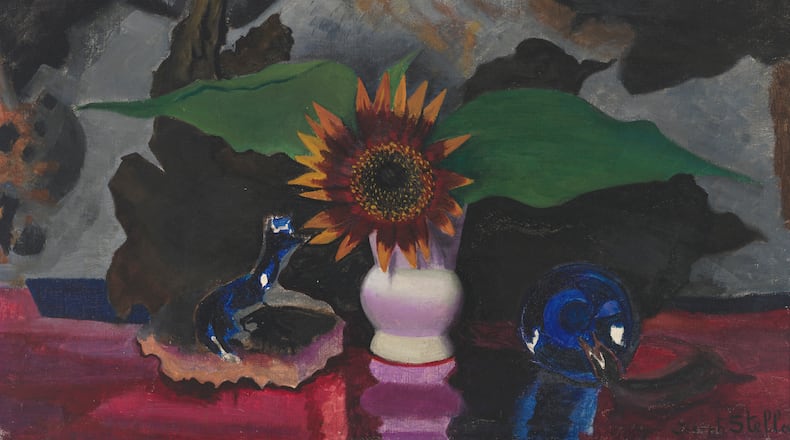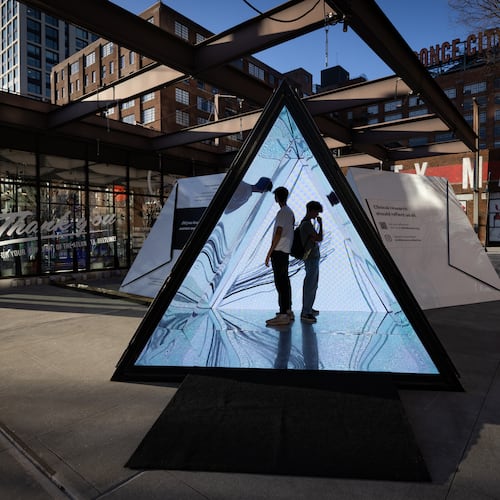This story was originally published by ArtsATL.
When I first encountered “Purissima,” Joseph Stella’s 1927 oil on canvas acquired by the High Museum of Art in 2000, I was enchanted by this phantasmagoric painting of a Madonna of purity. Facing center like a religious icon, she is flanked by linear, long-necked herons and stylized flora on a background of saturated cerulean blue, one of Stella’s favorite colors.
Credit: Handout
Credit: Handout
This amazing painting didn’t align with my understanding of Stella. Like many others, I knew him primarily for his modernist, urban paintings associated with Precisionism and Futurism, his Brooklyn Bridge works being his most emblematic.
The High’s “Joseph Stella: Visionary Nature,” organized in collaboration with the Brandywine Museum of Art, has now contextualized “Purissima” by gathering 120 paintings, drawings and collages from 36 museums and 25 collectors.
The works thematically explore Stella’s idiosyncratic renderings of nature and memories of Italy (which he visited frequently) as well as his extraordinary skills as draughtsman and colorist.
Credit: Bridgeman Images
Credit: Bridgeman Images
He was colleagues with, and aligned with, some of the most avant-garde artists and thinkers of his time, including Marcel Duchamp, Gertrude Stein, Gino Severini, Man Ray, Alfred Stieglitz and Georgia O’Keeffe. Yet, as this exhibition adeptly proves, he marched to his own spiritual drummer.
“Visionary Nature” (through May 21) is divided into nine sections, loosely chronological, each anchored by Stella’s words, much of which are translated from the original Italian. (Stella was a prolific, talented writer, and an admirer of American literature, particularly works by Walt Whitman and Edgar Allen Poe.)
Paintings and drawings of plants and birds dominate, including the 1924 “Dance of Spring (Song of Birds).” “Purissima” is in company with other paintings of the Virgin and a reclining Undine.
The Neapolitan landscape is frequently referenced by appearances of Mount Vesuvius and the Island of Capri. Toward the end of his life, Stella spent time in Barbados, and nature-based work and island portraits from that period are also included.
Born in the medieval town of Muro Lucano near Naples, Italy, in 1877, Stella emigrated to New York in 1896 to join his brother and study medicine. Clearly talented, he pivoted to pursue art at the Art Students League with William Merritt Chase and later worked as a magazine illustrator. Like many immigrants who lived in bustling, modern cities, he was mesmerized by the possibilities of the new American urban landscape.
On the other hand, he yearned for Italy, its light, colors and its historic past. He returned in 1909, immersing himself in Old Masters art and techniques. As the High exhibition demonstrates, his visits to his home country grounded the trajectory of his work.
Looking to expand as a Modernist artist, Stella went to Paris in 1911 where he encountered Fauvism, Cubism and Futurism, allowing him to think anew and expand beyond representational work towards abstraction.
He returned to New York and participated in the famous 1913 Armory Show with “Battles of Light, Coney Island.” This much talked about painting cemented his position in American avant-garde art circles of the time; his Brooklyn Bridge works would follow.
As fascinated as he was with America’s pulsing industry and architecture, Stella sought out the natural world at the New York Botanical Garden in the Bronx, which he visited frequently.
He drew and painted the flora and fauna collected from around the world, while also interpreting the engineering feats of the Brooklyn Bridge. Often organized in compositions with central axes, his urban and nature compositions are linked by their precisionist linear style, connected with visionary optimism.
Credit: Handout
Credit: Handout
The monumental 1919 “Tree of My Life,” on loan from the Art Bridges Foundation, is a centerpiece of “Visionary Nature.” The axis here is a tree topped with a beautifully rendered blue oculus and surrounded by identifiable but fantastic plants and birds, along with grottoes, in a complex, abstracted composition. “Tree of My Life” recalls such sources as early Renaissance paintings and 19th century Symbolism, and artists ranging from Hieronymous Bosch to Odilon Redon, but the painting is a modernist kaleidoscopic masterpiece in its own right.
Credit: Handout
Credit: Handout
There are other surprises in this exhibit such as collages and technically superb silverpoint drawings, including several self-portraits. Stella’s portraits, including one of Duchamp, are frequently in profile, referencing Italian Renaissance portraiture. (Stella accompanied Duchamp to New York’s Canal Street to purchase the infamous urinal used in that artist’s 1917 readymade “Fountain.”)
Stella’s nature-based works fell out of fashion in his lifetime. He died in 1947, noted mostly for his urban work. Fortunately, his visionary and, one could argue, his most personal works were collected through the ensuing decades, allowing for this in-depth reconsideration. Kudos to the High and Brandywine for organizing this ambitious undertaking and giving Stella the deep look he deserves.
ART REVIEW
“Joseph Stella: Visionary Nature”
Through May 21. 10 a.m.-5 p.m. Tuesdays-Saturdays; Noon-5 p.m; Sundays. $16.50, ages 6 and older; free for children 5 and younger and members. High Museum of Art, 1280 Peachtree St. NE, Atlanta. 404-733-4444, high.org.
::
Louise E. Shaw has been a cultural worker in Atlanta for over 40 years. She served as executive director of Nexus Contemporary Art Center from 1983-1998, and was on Eyedrum’s ad hoc advisory board in the 2000s.
Credit: ArtsATL
Credit: ArtsATL
MEET OUR PARTNER
ArtsATL (www.artsatl.org), is a nonprofit organization that plays a critical role in educating and informing audiences about metro Atlanta’s arts and culture. Founded in 2009, ArtsATL’s goal is to help build a sustainable arts community contributing to the economic and cultural health of the city.
If you have any questions about this partnership or others, please contact Senior Manager of Partnerships Nicole Williams at nicole.williams@ajc.com.
About the Author
Keep Reading
The Latest
Featured






